Lena von Goedeke
Works of art by Lena von Goedeke
Lena von Goedeke´s works - painstaikingly manufactured paper cuts, penderous, while seemingly hovering landscapes made of concrete sand, delicate drawings, dragging themselves across the entire wall - have to be witnessed in original to be comprehended. The fine, dusty sand, that ripples down from the side, leaving a barren landscape; the glitter and shine of reflector foil cut into sculptural patterns: The material, it´s textures and surfaces mesmerize the gaze, raising contradictions and questions.
Intrusiva, 2022
Intrusiva
The bronze named Intrusiva, an arm made of bronze, is covered with deep black patina. On the vulnerable inner side of the wrist, cuts and cracks are visible, which are imprints of volcanic rocks from Iceland. The imprint gives the appearance of veins, which is in direct contact with the flowing lava.
Since 2020, Lena von Goedeke has been working with lava and lava rocks, especially in Iceland. Several trips there inspired her, among other things, to the work Intrusiva.
The bronze named Intrusiva, an arm made of bronze, is covered with deep black patina. On the vulnerable inner side of the wrist, cuts and cracks are visible, which are imprints of volcanic rocks from Iceland. The imprint gives the appearance of veins, which is in direct contact with the flowing lava.
Since 2020, Lena von Goedeke has been working with lava and lava rocks, especially in Iceland. Several trips there inspired her, among other things, to the work Intrusiva.

Aggregate, 2022
Aggregate
The glass works from the Aggregates series refer to the extraction of drill cores from the Arctic ice and the scientific analysis of the layers, which document the climatic development of the earth over thousands of years as "climate archives". In the work process, the artist has added materials to her objects that make up her own existence, such as hair and breath, and thus created her very own archives.
With her glass works from the Aggregate series, the artist directly addresses the current issues of our time with regard to climate change.
The glass works from the Aggregates series refer to the extraction of drill cores from the Arctic ice and the scientific analysis of the layers, which document the climatic development of the earth over thousands of years as "climate archives". In the work process, the artist has added materials to her objects that make up her own existence, such as hair and breath, and thus created her very own archives.
With her glass works from the Aggregate series, the artist directly addresses the current issues of our time with regard to climate change.
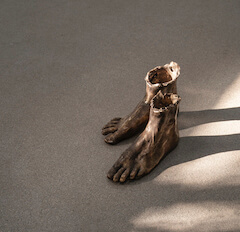
We all fall to the center, 2022
We all fall to the center
The bronze feet called We all fall to the center stand still in the exhibition, like a silent observer.
In the spring of 2022, the artist traveled to Spitsbergen, where she heated them and placed them in the Arctic ice. She filmed how the hot metal slowly and laboriously sank into the ground. This process can be seen in the video of the same name.
The bronze feet called We all fall to the center stand still in the exhibition, like a silent observer.
In the spring of 2022, the artist traveled to Spitsbergen, where she heated them and placed them in the Arctic ice. She filmed how the hot metal slowly and laboriously sank into the ground. This process can be seen in the video of the same name.
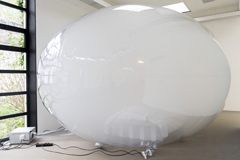
The Oneironaut (lab), 2021
The Oneironaut (lab), 2021
Side-specific installation for the group exhibition Borderlines of Space, Galerie m
The air bubble in Lena von Goedeke’s room installation The Oneironaut (lab) seems to float between the walls of the exhibition gallery. The monumental elliptical sphere nearly fills the room. Machines and cables outside the bubble give us a vague impression of the complexity of the sphere but also hint at a functional connection between inside and outside and at the titular laboratory situation.
Side-specific installation for the group exhibition Borderlines of Space, Galerie m
The air bubble in Lena von Goedeke’s room installation The Oneironaut (lab) seems to float between the walls of the exhibition gallery. The monumental elliptical sphere nearly fills the room. Machines and cables outside the bubble give us a vague impression of the complexity of the sphere but also hint at a functional connection between inside and outside and at the titular laboratory situation.

Habitable Zone II, 2019
Arctic Circle
For three weeks Lena von Goedeke traveled around Svalbard (Spitzbergen), while spending two of them onboard of the Barkentine Antigua, together with 34 people of different disciplines. In The arctic blog (in german), the artist gathered all of her impressions and experiences she made during her travels.
For three weeks Lena von Goedeke traveled around Svalbard (Spitzbergen), while spending two of them onboard of the Barkentine Antigua, together with 34 people of different disciplines. In The arctic blog (in german), the artist gathered all of her impressions and experiences she made during her travels.
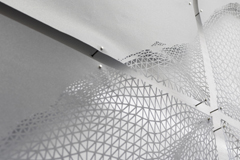
Detail Lot VI, 2018
Lots
Lena von Goedeke first designed the three-dimensional web of silhouettes with the help of a computer program used to generate virtual worlds and then assiduously cut the negative areas out by hand.
Lena von Goedeke first designed the three-dimensional web of silhouettes with the help of a computer program used to generate virtual worlds and then assiduously cut the negative areas out by hand.
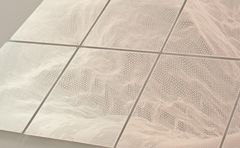
Detail Radar II, 2018
Radar
As one of the first remote sensing techniques of mankind, the radar method as a satellite-based georadar has a special significance in the exploration, measurement and documentation of the earth's surface and crust. In contrast to other techniques, the radar is able to scan the earth's surface even on cloudy days or at night, and has an advantage over purely optical methods such as triangulation or even the human gaze.
As one of the first remote sensing techniques of mankind, the radar method as a satellite-based georadar has a special significance in the exploration, measurement and documentation of the earth's surface and crust. In contrast to other techniques, the radar is able to scan the earth's surface even on cloudy days or at night, and has an advantage over purely optical methods such as triangulation or even the human gaze.
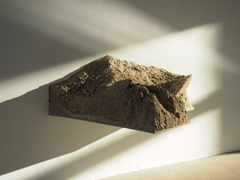
Zombie (7), 2018
Zombies
A sensory level is precisely so central to Lena von Goedeke’s works, which is why the objects and their nature demand such close scrutiny. It is all about their existence in the here and now, about encountering them face-to-face.
A sensory level is precisely so central to Lena von Goedeke’s works, which is why the objects and their nature demand such close scrutiny. It is all about their existence in the here and now, about encountering them face-to-face.
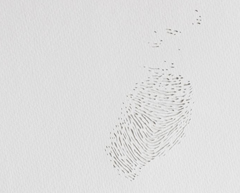
Detail Certificate, 2018
Certificates
The genesis of Lena of Goedeke’s works is closely linked with electronic data processing. This is symbolically conveyed in the Certificates with a fingerprint as reference to our existence between the analogue and the virtual worlds: the digital fingerprint that tracks our online activity, the unlocking of a touch screen and the touch screen as such, the finger that grants us access to a virtual world where, paradoxically, at the moment it is “entered,” the tactile level, along with so many other levels of sensory perception, becomes meaningless.
The genesis of Lena of Goedeke’s works is closely linked with electronic data processing. This is symbolically conveyed in the Certificates with a fingerprint as reference to our existence between the analogue and the virtual worlds: the digital fingerprint that tracks our online activity, the unlocking of a touch screen and the touch screen as such, the finger that grants us access to a virtual world where, paradoxically, at the moment it is “entered,” the tactile level, along with so many other levels of sensory perception, becomes meaningless.
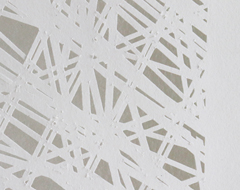
Detail Papercut, 2018
Papercuts
In this era of digitalization and artificial intelligence, Lena von Goedeke explores the merging of analogue and digital technologies and their perception. The discrepancy between the content of our subjective experiences of the two different worlds is made manifest in her objects, related as they are to both, thus stimulating thinking on many different levels.
In this era of digitalization and artificial intelligence, Lena von Goedeke explores the merging of analogue and digital technologies and their perception. The discrepancy between the content of our subjective experiences of the two different worlds is made manifest in her objects, related as they are to both, thus stimulating thinking on many different levels.
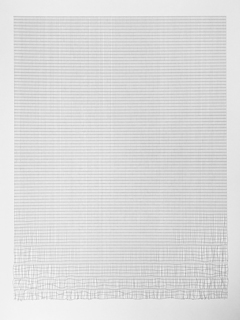
Wear 2, 2019
Ink drawings
The ink drawings from the series "Kenzo", "Wear" and "Astra" are based on the same grid. The works each go through different development processes in the area of digital processing and realization on paper. In the process of creation between manual design and automated implementation, hardware, the artist's handwriting and the plotter leave their own traces. Deviations from the regularity of the original pattern raise questions of standardization, perfection and individuality and point to the vivid blurs in the translation of ideas into the digital.
"So there are flaws where the pen did not rest completely due to paper waves, weak lines where the ink did not run fast enough or "wipe traces" where fluff gathered at the tip of the pen. In this way my computer infrastructure constantly produces unique specimens, the more energy I put in by hand to work as accurately as possible."
Lena von Goedeke, 2020
The ink drawings from the series "Kenzo", "Wear" and "Astra" are based on the same grid. The works each go through different development processes in the area of digital processing and realization on paper. In the process of creation between manual design and automated implementation, hardware, the artist's handwriting and the plotter leave their own traces. Deviations from the regularity of the original pattern raise questions of standardization, perfection and individuality and point to the vivid blurs in the translation of ideas into the digital.
"So there are flaws where the pen did not rest completely due to paper waves, weak lines where the ink did not run fast enough or "wipe traces" where fluff gathered at the tip of the pen. In this way my computer infrastructure constantly produces unique specimens, the more energy I put in by hand to work as accurately as possible."
Lena von Goedeke, 2020
